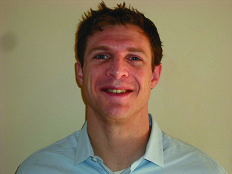By Bob Gorinski, DPT
We rarely think about our shoulders until something goes wrong. We ask a lot of our shoulders, so it should be no surprise they are frequently problematic. Our shoulders move frequently, in all directions, and through an extremely large range of motion.
How can we care for and nurture our shoulders? We must be aware of four ways that we often sabotage our shoulders.
1. Reaching and lifting with poor form:
Shoulders function best when the top portion of the humerus (the upper arm bone) has margin to spin and glide in the socket formed by the shoulder blade (scapula) and collar bone (clavicle). If you lift and carry objects with the palm of the hand facing downward and your elbow out to the side, the humerus is less stable in the shoulder socket, and the rotator cuff muscles and bursa can easily get pinched between the moving bones.
Whenever possible, reach overhead and lift with the palm of the hand facing up and your elbow more toward the center of your body rather than out to the side.
2. Slumping when we sit:
The foundation of many shoulder issues is poor sitting posture. Much of adult life is sit-sit-sit-sit. And after that, we sit. Sitting itself is not stressful on the shoulder joint, but problems can easily occur when stiffness and poor alignment has developed over months and years.
The first key to good shoulder health is being aware of the poor posture that many of us apply to our bodies. Sit up tall. Stand up and move. Pull your head and shoulder blades back.
3. Weekend projects:
High-performing athletes diligently train their bodies and closely monitor use of their shoulders. In contrast, the average adult frequently dives into weekend painting, trimming, and cleaning projects with little physical preparation to protect their shoulders. Even with perfect posture and lifting technique, chances are slim that the shoulder muscles, ligaments, and tendons will hold up.
Be aware of the demands that weekend projects will place on the shoulders. Take time to prepare by stretching and strengthening the muscles of the shoulders and upper back.
4. Exercising our shoulders:
Exercise programs are one of the biggest risk factors for shoulder injuries. Many people with the best of intentions take on too much too soon, perform exercises that are simply not a good idea, or fail to address postural and alignment issues prior to performing typical upper body strengthening and stretching.
To minimize shoulder injury during exercise:
Stay off the machines. Most resistance exercise machines do not require you to activate the core muscles that support good posture and movement of the shoulder blades. If a machine, rack, or person has to hold the weight for you, it may be more than the shoulder is prepared to handle. In contrast, sitting or standing dumbbell presses are self-limiting. These exercises demand support from the stabilizing muscles in the torso and you will not attempt to shoulder more than you can handle.
Stretch what is tight but avoid indiscriminately stretching what’s already loose. Instead of aggressively stretching the shoulder joints, stretch the upper back and pectoral muscles.
Strengthen what is loose but not what is already tight. Most of us need more upper back strengthening work and less work on the chest and biceps as these muscle groups pull the shoulder blades forward.
Shoulder pain is the third most common musculoskeletal problem treated by physical therapists and our risk increases as we age. Protect your shoulders by practicing good posture, not pushing your body to do more than it safely can, and selecting exercises to strengthen and stretch your upper back and pectoral muscles.

By Bob Gorinski, DPT
Full Reps Physical Therapy
Bob Gorinski, DPT, is a physical therapist and owner of Full Reps Physical Therapy in Camp Hill, PA. He specializes in orthopedic rehabilitation and has provided detailed personal training to athletes, young and old, to maximize their physical performance and prolong their years of high level function. He loves helping others feel, look, and perform their best! You can reach him by email at bobg@fullrepstraining.com and on the web at fullrepstraining.com.
Featured in Commercial Real Estate Review – Second Quarter 2018

